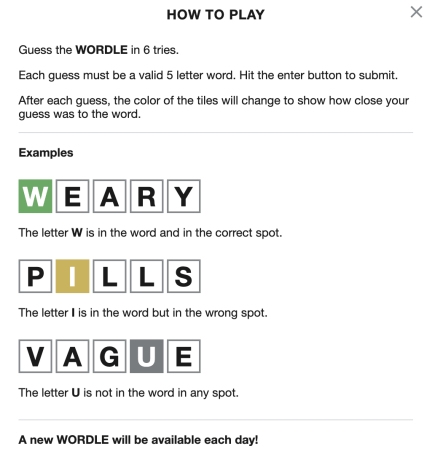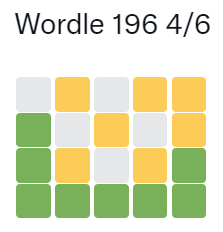Wordle: More Than Just A 5-Letter Word

March 24, 2022
Six chances. Five letters. Three colors. One word. This highly addictive game that has grown into a new obsession, surmounting the Times crosswords, sudoku puzzles, and other daily games of the world… what’s the word again? Oh, right, WORDLE!
To all the Scrabble, sudoku, and logic game fans of the world, this game is for you. But Wordle is not merely confined to the avid word-lovers; this game is for anyone and everyone.
Wordle is a daily game played online. It’s a fun, simple, brain-boosting game, which—like crosswords on the New York Times—can only be played once a day. When the clock strikes midnight, players must guess a new five-letter word. But here’s the catch: no hints, just 26 letters to choose from.

After each guess, Wordle alerts players whether any of the inputted letters from the guessed word is either in the correct spot (green), a different spot (yellow), or not part of the word at all (gray). Players must guess the correct word within a total of six tries. After five chances, players must use the color-coded letters to formulate the correct “wordle” of the day. Or players can try for performance, using various strategies, to win in three, two, or—with luck of the draw—one try.
So, how did this game become so viral in the first place? Well, according to The New York Times, Wordle is a “love story” created by Josh Wardle, a software engineer from Brooklyn. As a gift for his partner, a word-game fanatic, he developed this guessing game between the two of them, and named it Wordle as a play on his last name. After playing together for months, he introduced the game to his family and friends through WhatsApp group chats. As the game received high praise from those who played it, Wardle thought this could transform into something bigger and better, and he released it to the world in October, 2021. On November 1, 90 people played. Two months later, 300,000 people played. And now, millions of people play daily.
About three months after Wordle’s inception, the Times bought Wordle for a price in the low seven figures. This addition to the Times’s games—the crossword, Spelling Bee, Letter Boxed, Tiles, and Vortex—is a merry step in the company’s pursuit of increasing its digital subscriptions. Since Wardle drew much inspiration from the Times’s games, selling Wordle to the New York Times “felt very natural” to him.

What makes this straightforward yet simultaneously complex game so compelling is that there’s only one puzzle a day, creating extremely high-stakes in the game. Players get one chance a day, and if you don’t get the word in six tries, you have to wait another day for a brand new word. Furthermore, everyone—globally—is solving the same puzzle. Comments like “How many tries did it take you today?” and “Today’s puzzle was hard!” dispersing throughout workspaces makes the game all the more viral. Even better, Wordle results are easily shareable; with a simple tap on the “SHARE” icon, the game creates an obscured version of your results with a combination of green, yellow, and grey emojis to share with friends. These series of green, yellow, and grey boxes have flooded Twitter, Instagram, Facebook, and other major communication platforms, making Wordle a viral sensation.
This game is not just plain fun, though, as it increasingly activates players’ brains, not only by improving memory, but also overall brain power. “Anything that causes a high level of engagement–something that engages memory, problem solving–is good for your brain, and will strengthen those processes in your brain,” Earl Miller, PhD, professor of neuroscience at the Massachusetts Institute of Technology told WebMD.
After becoming a viral sensation, many active players have adopted strategies and approaches to their daily Wordle games in order to better their statistics. Here are some of the most commonly used strategies:

- Knock out your vowels.
- Ah, the good old “ADIEU.” Four out of five of the vowels are wiped out at once. A favorite for some, an underdog move for others.
- Knock out the most common letters.
- “STARE” and “IRATE” are fan favorites because they contain the most commonly used letters in the English alphabet: e, a, r, i, o, t, n, s, l, c.
- Or, simply rely on your intuition.
- What’s it going to be today? “STAIR,” “AROSE,” “AUDIO,” “TEARY?” Who knows? Let your intuition crack the code.
Time to put these strategies to a test. Play Wordle today!
















































































































































